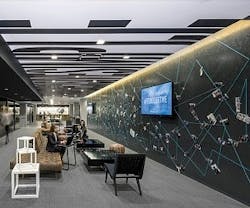There’s something rather satisfying for the design-minded person about being among the first to identify emerging trends in the interiors world. With a discerning eye and palette, forward-thinking designers always seem to know when an idea, solution, furniture, or material will take off and capture the market’s attention—and dollars.
Then there’s the flip side: when a trend has long passed the tipping point and entered the realm of the tired and overdone. (And why is it that we tend to beat things to death anyway?)
Here are 5 design trends we’d like to see fade in the near future—perhaps not into obsolescence, but at least the volume could be turned down some. We hope you’ll share your thoughts in the comments section or hit us up with a tweet (@interiorssource) about what trends you’d like to see disappear.
- The Open Office. There, we said it. While open office plans have been the de facto corporate office standard for years, the pendulum has swung too far. Let’s face it: most people don’t like working in a fish bowl (can I get an “amen” from the introverts?). And with articles from The Washington Post declaring, “Google got it wrong,” to The New Yorker claiming the open office is “a trap,” to research from Gensler and Steelcase suggesting that workspaces need to address the “privacy crisis” in the open office, we think it’s time to take things down (or build things up, rather) a couple of notches to allow greater room for privacy.
- Midcentury Modern. Look, we loved Mad Men as much as anyone, but too much of a good thing can be bad. The occasional Jacobsen , Knoll or Eames chair is great—we’re not against classics (far from it), but we get the feeling Don Draper would hardly know know time had passed if he waltzed into some corporate interiors today.
- Stainless steel appliances (and granite countertops). This combination of appliances and countertops is so overdone, it’s become a cookie cutter. While there are plenty of alternative surfacing materials that are making an entrance into kitchens, including concrete, solid surface, and quartz to name a few, appliances seem to be stuck. A 2016 Kitchen Trends survey by Houz published in the Washington Post found that 75% of respondents planning to renovate their kitchens are sticking to stainless. One article suggests the future of appliances will be black stainless steel. We’re not opposed necessarily, as long as some color is introduced elsewhere.
- The Edison Bulb. We get it: the exposed carbon filament of these vintage bulbs give any space an industrial, almost Steampunk feel while casting a warm glow. No doubt, they are cool and seem to be the perfect counterpoint to the LED lovefest. But as one blogger noted, this is the “trend that won’t end,” and by the looks of most restaurants still capitalizing on the Craft/Maker movement, they’re right.
- Chalkboard Walls. Although they invoke nostalgia and serve as an alternative to white boards, chalkboard-painted walls are bordering on uninspiring. Might we suggest something equally low-tech, yet interactive, such as a photo wall/gallery like the one featured in the photo above of media company Initiative’s Upper East Side office, designed by Ted Moudis Associates? The back wall is a strand board, which is essentially just plywood, stained black, and linked together with string and nails, and utilizes old-school clothes pins to post photos and notes. Like city streets plastered with posters and flyers, it is ever-changing, dynamic, and interactive.
About the Author
Robert Nieminen
Chief Content Director
Chief Content Director, Architectural Products, BUILDINGS, and interiors+sources
Robert Nieminen is the Chief Content Director of three leading B2B publications serving the commercial architecture and design industries: Architectural Products, BUILDINGS, and interiors+sources. With a career rooted in editorial excellence and a passion for storytelling, Robert oversees a diverse content portfolio that spans award-winning feature articles, strategic podcast programming, and digital media initiatives aimed at empowering design professionals, facility managers, and commercial building stakeholders.
He is the host of the I Hear Design podcast and curates the Smart Buildings Technology Report, bringing thought leadership to the forefront of innovation in built environments. Robert leads editorial and creative direction for multiple industry award programs—including the Elev8 Design Awards and Product Innovation Awards—and is a recognized voice in sustainability, smart technology integration, and forward-thinking design.
Known for his sharp editorial vision and data-informed strategies, Robert focuses on audience growth, engagement, and content monetization, leveraging AI tools and SEO-driven insights to future-proof B2B publishing.

